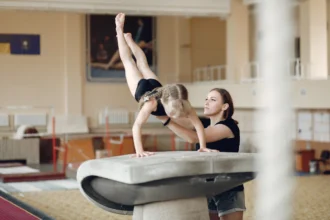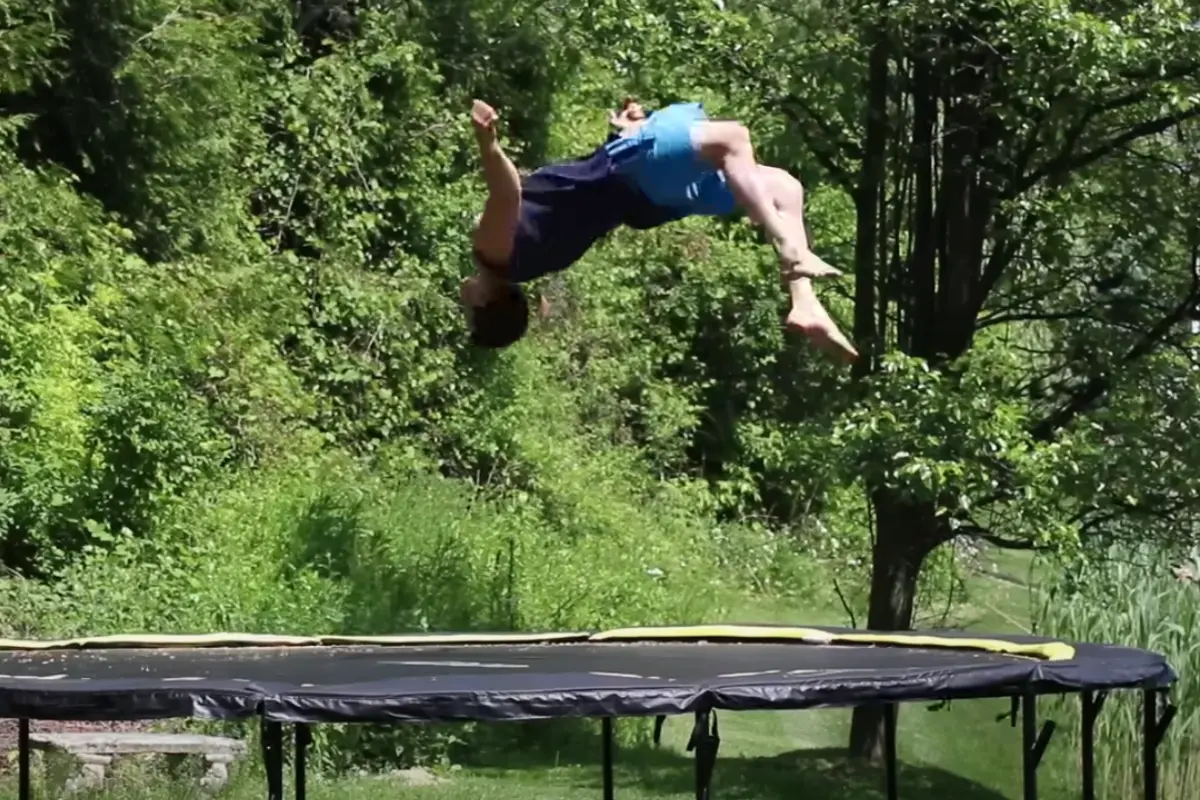If you’ve always dreamed of mastering the backflip, a trampoline offers the perfect training ground. Its forgiving, bouncy surface creates an ideal environment for building confidence and developing proper technique, making it significantly safer than attempting flips on solid ground.
In this comprehensive guide, we’ll walk through a 5-minute backflip progression that will help you safely and confidently execute backward flips.
Step 1: Getting Comfortable with Falling Back
Conquering the fear of backward motion is essential for learning a backflip. This foundational step builds mental confidence while establishing proper body positioning. You’ll gradually become comfortable with backward momentum while learning to trust the trampoline’s responsive surface.
Falling Back Safely
Position yourself in the trampoline’s center with feet precisely shoulder-width apart, establishing a stable base. Execute a controlled backward fall, similar to a trust fall exercise, maintaining a straight body position throughout the movement.
Keep your chin slightly tucked to protect your cervical spine, and focus on achieving a soft, controlled landing on your upper back. Relaxation is crucial – allow your body to work in harmony with the trampoline’s absorption. Consider having a trained spotter nearby during initial attempts to boost confidence and ensure safety.
Introducing a Small Bounce
After mastering the static fall, incorporate gentle bouncing. Create a small, controlled bounce before initiating your backward fall, allowing the trampoline’s elastic response to guide your movement naturally.
Maintain loose, relaxed body positioning while avoiding tension in your muscles. Continue tucking your chin and resist the urge to look over your shoulder, as this can compromise your spinal alignment. Focus on feeling how the trampoline’s bounce affects your fall dynamics compared to the stationary drop.
Step 2: Rolling Back for Backflip Preparation
With backward falls mastered, progress to more dynamic movements that directly translate to backflip mechanics.
Bounce and Backward Roll
Begin with a controlled bounce, then initiate a backward fall onto the trampoline. Upon back contact, execute a fluid backward roll by drawing your knees tightly to your chest, using your hands to guide the rotation.
This movement develops spatial awareness and rotational control. If bouncing feels overwhelming, perfect the backward roll from a static position until you’re ready to add the dynamic element.
Using Momentum to Return to Your Feet
Maintain consistent bouncing while progressing from finishing on your back to completing the roll on your feet. Focus on explosive leg drive as you exit the roll, keeping your body compact and utilizing the trampoline’s rebound effectively.
This progression is vital for transitioning to full flips, as it teaches continuous rotational momentum while maintaining balance and spatial orientation.
Step 3: Practicing Side-Flipping
This phase introduces inversion through lateral movements, creating a bridge between rolling and full backward rotation. The goal is to evolve from cartwheel mechanics to backward rotational patterns.
Start with a Dominant-Side Cartwheel
Execute a standard cartwheel on your dominant side, adapting to the trampoline’s unique surface characteristics. Take time to adjust to how the springy surface affects your movement patterns.
Gradually modify your cartwheel by incorporating slight backward lean, guiding your feet to travel more directly over your center of mass rather than laterally. This subtle adjustment introduces backward rotation while maintaining the security of familiar movement patterns.
Progress to an Over-the-Shoulder Handspring
Transform your modified cartwheel into an over-the-shoulder handspring. Focus on explosive hand drive while maintaining shoulder alignment, guiding your body through a diagonal rotational path.
This movement develops backward arc awareness while maintaining control. Stay relaxed and use the trampoline’s bounce to generate height and build confidence. Progress by gradually lifting your legs higher, working toward vertical rotation without rushing full backward commitment.
Step 4: Transitioning from Cartwheel to Backflip
This critical phase bridges the gap between lateral and vertical rotation. Your goal is to progress from diagonal movement patterns to complete backward rotation while maintaining confidence and control.
Refine the Diagonal Rotation
Continue practicing modified cartwheels while increasing backward trajectory. Initiate movement by driving both arms over your dominant shoulder, adjusting body position to create diagonal rotation rather than horizontal displacement.
Generate powerful momentum through synchronized arm swing, driving upward and backward to facilitate more vertical rotation. This progression maintains familiar movement patterns while developing the mechanics needed for full backward rotation.
Lower the Landing and Emphasize Rotation
Progressively transition your landing point from knees to torso, focusing on controlled backward rotation throughout the movement. Use your hands strategically to guide your path, ensuring smooth, controlled descent.
Engage your core muscles to actively pull your knees toward your chest, increasing rotational velocity. This develops essential muscle memory and spatial awareness in the inverted position, preparing you for complete backward rotation.
Step 5: Mastering the Backflip
The final phase synthesizes all previous progressions, transforming diagonal movement into pure backward rotation.
Perfecting the “Makaku” Technique
Begin with the “Makaku” – a hybrid movement combining shoulder-oriented rotation with vertical leg drive. This technique maintains some lateral movement for added security while developing full rotational mechanics. Maintain core engagement throughout to ensure positional control.
Practice ground spotting midway through rotation to maintain orientation and prepare for landing. The combination of core tension and proper arm guidance creates smooth, controlled rotation through all phases of the movement.
Transition to a Full Backflip
Progress from the “Makaku” to pure backward rotation by emphasizing vertical takeoff mechanics. Focus on powerful, straight-up jumping rather than excessive backward lean, ensuring strong, stable initiation.
Maximize rotation speed by aggressively tucking your knees mid-flight. Maintain visual contact with the trampoline throughout rotation, allowing early landing preparation. As you spot the surface, engage your core and extend your legs progressively for optimal landing stability.
Additional Tips for Success
- Spot Your Landing: Develop consistent visual tracking during rotation. Early trampoline spotting enables proactive landing preparation and enhanced control.
- Tuck Tight: Maximize rotation speed at the jump’s apex through aggressive knee-to-chest positioning. This creates faster, more controlled rotation.
- Overcome the Fear: Mental preparation is crucial for backflip success. The progressive drills systematically build confidence and reduce anxiety about backward rotation.
- Don’t Rush It: Progress at your own pace through each phase. Thorough mastery of fundamentals ensures safe, successful skill development.
Conquering the backflip is all about overcoming the mental hurdle. Once you manage that, refining your technique and style becomes the fun part. This method breaks down the fear and makes it manageable, helping you build up to the full flip safely.





